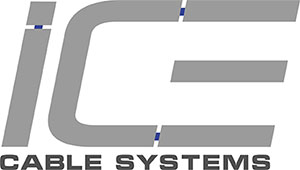 As a female in the security industry, sometimes things tend to be a bit…how do you say it? Well, bland. In my opinion, one such product is cable and wiring. I understand that it is a needed supply in the security industry, but let’s face it, isn’t biometrics and security systems that can control your home, transforming it into a “smart home” much more interesting? I sure thought so until I spoke with Brian Rizzo, president of ICE Cable Systems, who opened my eyes to the fun, interesting side of wire and cable.
As a female in the security industry, sometimes things tend to be a bit…how do you say it? Well, bland. In my opinion, one such product is cable and wiring. I understand that it is a needed supply in the security industry, but let’s face it, isn’t biometrics and security systems that can control your home, transforming it into a “smart home” much more interesting? I sure thought so until I spoke with Brian Rizzo, president of ICE Cable Systems, who opened my eyes to the fun, interesting side of wire and cable.
For about 10 years, within the residential custom AV channel, Rizzo watched as installers expressed their frustration with the industry, which prompted him to embark on a journey to discover the gaps and develop products to fix them.
After surveying the market, Rizzo discovered that overall, installers were tired of wrestling with strand after strand of cable and wiring that would tangle, kink and bunch, and simply wanted a cable that was fast and easy to install.
 Rizzo rose to the challenge by packing up and moving to China because “the Chinese built a superior product that could not be bought in the US.” Overseas, he learned that the “secret sauce” is to offer premium value in a product that is faster for installers to install while solving installation problems at a competitive price.
Rizzo rose to the challenge by packing up and moving to China because “the Chinese built a superior product that could not be bought in the US.” Overseas, he learned that the “secret sauce” is to offer premium value in a product that is faster for installers to install while solving installation problems at a competitive price.
This translated well into the security industry.
Choosing a Cable Vendor
The importance of choosing a cable vendor to work with can make or break a project.
“Most installers see wire and cable as just a commodity,” explained Rizzo. “A contractor building a home looks at nails as a commodity. The security industry looks at wire and cable the same way. But this isn’t the case with wire and cable at all; you get what you pay for.”
So, how exactly do you, as an installer, know who to trust when choosing a vendor?
“For installers to really, really know, they need to have a micrometer, grab products from multiple companies and test them,” said Rizzo.
Obviously, this an extremely time consuming process, so to save time and make it a bit easier Rizzo suggests getting into the specifics of each company and find out how they build their products.
“If a company is building their products right, their message is ‘hey, we build it right; we add value, save time and money, and eliminate the risk of embarrassment of product performance. Oh, and by the way, we are competitively priced’ as opposed to talking about price first or featuring price.”
The Cheapest Isn’t Always the Best
One of the most common myths is that all wiring and cable is the same, so installers opt to simply buy the cheapest available. After all, wire’s simply just that…wire, right? Well, not exactly.
Purchasing inexpensive cable means you are taking a huge risk because the only effective way to build cable cheaply is to cut corners. Some companies go to extreme measures to save money, including shaving off copper or changing foot markers, both of which can lead to disaster.
“Compounds must be made a certain way for safety,” continued Rizzo. “It turns out that compounds that do not make safety ratings are cheap, so some companies use them. The average installer doesn’t know this.”
Case in point, there was a security project in which a network of surveillance cameras was being installed that required medium and long runs of camera cable. When the installer went to activate the surveillance cameras, a number of them wouldn’t power-up. ICE helped the integrator identify that the manufacturer of the cable had been shaving copper wherein the 18/2 actually proved to be 22/2. Not only was the reputation of the installer compromised, but a whole rip-and-replace was required, which caused money loss on the project.
“The structural backbone of the system is not where to save money,” concluded Rizzo.
With a smorgasbord of wire and cable products available in the marketplace, too many options can make it confusing to wade through and choose the best solutions for specific projects.
“You don’t need eight different brands,” explained Rizzo. “There is a sweet spot that makes sense for each project.”
Sometimes it’s best to define and describe what is NOT needed in order to determine what is.
Unkinking to Make Installation Easier
When it came time for ICE Cable Systems to create their product, they did not focus on the way in which their cabling and wiring was made, which is what I would have expected. Instead, they focused on the box.
Because they reverse engineer all their products, this company works from the end goal back to the beginning, which allows them to make better products overall. Knowing that installers were frustrated with tangling, twisting, and kinking cable and wire, ICE Cable Systems choose to focus on creating a box that would prevent these frustrations.
Known as a BMP (big mouth payout) box, it has a 4-inch payout hole, where other boxes have only a 1-inch payout hole. With a small payout, if an installer is on a ladder, the box would eventually climb the ladder too, as the installer pulls on the cable during the installation process, resulting in the need for a two-man pull. Using proprietary line inside ICE’s box with a 4-inch payout not only eliminates kinking, twisting, and tangling but it also allows for a one-man pull. Taking it one step further, ICE’s box is built like a tank with special cardboard, reinforced handles and laminated on the outside to help with water resistance.
The result? A bullet-proof box that is a time and money saver.
Rizzo reasoned that the amount of work that ICE put into creating the perfect box demonstrated the amount of work that they put into making their cable, so it helps installers draw conclusions on the value of their overall product.
When the ICE Cable Systems representative pitched the idea of doing a story about wire and cable, I wasn’t too sure what to expect. In the end, what I got was a story that took me from the U.S. to China, back to the U.S., all in the name of premium valued wire and cable that is competitively priced and easy to install.